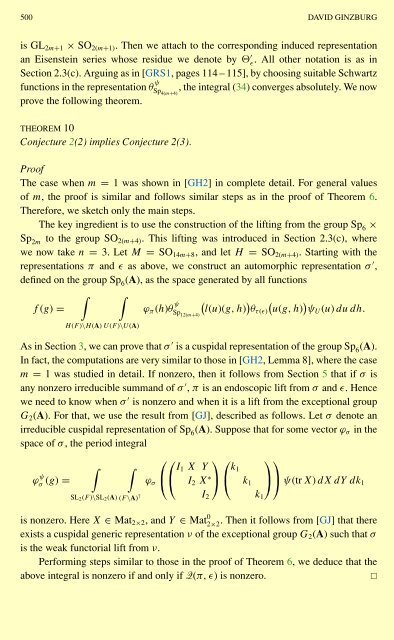A NULLSTELLENSATZ FOR AMOEBAS
A NULLSTELLENSATZ FOR AMOEBAS
A NULLSTELLENSATZ FOR AMOEBAS
You also want an ePaper? Increase the reach of your titles
YUMPU automatically turns print PDFs into web optimized ePapers that Google loves.
500 DAVID GINZBURG<br />
is GL 2m+1 × SO 2(m+1) . Then we attach to the corresponding induced representation<br />
an Eisenstein series whose residue we denote by ′ ɛ<br />
. All other notation is as in<br />
Section 2.3(c). Arguing as in [GRS1, pages 114 – 115], by choosing suitable Schwartz<br />
functions in the representation θ ψ Sp 4(m+4)<br />
, the integral (34) converges absolutely. We now<br />
prove the following theorem.<br />
THEOREM 10<br />
Conjecture 2(2) implies Conjecture 2(3).<br />
Proof<br />
The case when m = 1 was shown in [GH2] in complete detail. For general values<br />
of m, the proof is similar and follows similar steps as in the proof of Theorem 6.<br />
Therefore, we sketch only the main steps.<br />
The key ingredient is to use the construction of the lifting from the group Sp 6 ×<br />
Sp 2m to the group SO 2(m+4) . This lifting was introduced in Section 2.3(c), where<br />
we now take n = 3. LetM = SO 14m+8 ,andletH = SO 2(m+4) . Starting with the<br />
representations π and ɛ as above, we construct an automorphic representation σ ′ ,<br />
defined on the group Sp 6 (A), as the space generated by all functions<br />
∫ ∫<br />
f (g) =<br />
ϕ π (h)θ ψ ( ) ( )<br />
Sp 12(m+4)<br />
l(u)(g, h) θτ(ɛ) u(g, h) ψU (u) dudh.<br />
H (F )\H (A) U(F )\U(A)<br />
As in Section 3, we can prove that σ ′ is a cuspidal representation of the group Sp 6 (A).<br />
In fact, the computations are very similar to those in [GH2, Lemma 8], where the case<br />
m = 1 was studied in detail. If nonzero, then it follows from Section 5 that if σ is<br />
any nonzero irreducible summand of σ ′ , π is an endoscopic lift from σ and ɛ. Hence<br />
we need to know when σ ′ is nonzero and when it is a lift from the exceptional group<br />
G 2 (A). For that, we use the result from [GJ], described as follows. Let σ denote an<br />
irreducible cuspidal representation of Sp 6 (A). Suppose that for some vector ϕ σ in the<br />
space of σ , the period integral<br />
⎛⎛<br />
⎞ ⎛ ⎞⎞<br />
∫ ∫ I 1 X Y k 1<br />
ϕ ψ σ (g) =<br />
ϕ σ<br />
⎝⎝<br />
I 2 X ∗ ⎠ ⎝ k 1<br />
⎠⎠ ψ(tr X) dXdY dk 1<br />
SL 2 (F )\SL 2 (A) (F \A) I 7 2 k 1<br />
is nonzero. Here X ∈ Mat 2×2 ,andY ∈ Mat 0 2×2<br />
. Then it follows from [GJ] that there<br />
exists a cuspidal generic representation ν of the exceptional group G 2 (A) such that σ<br />
is the weak functorial lift from ν.<br />
Performing steps similar to those in the proof of Theorem 6, we deduce that the<br />
above integral is nonzero if and only if Q(π, ɛ) is nonzero.
















